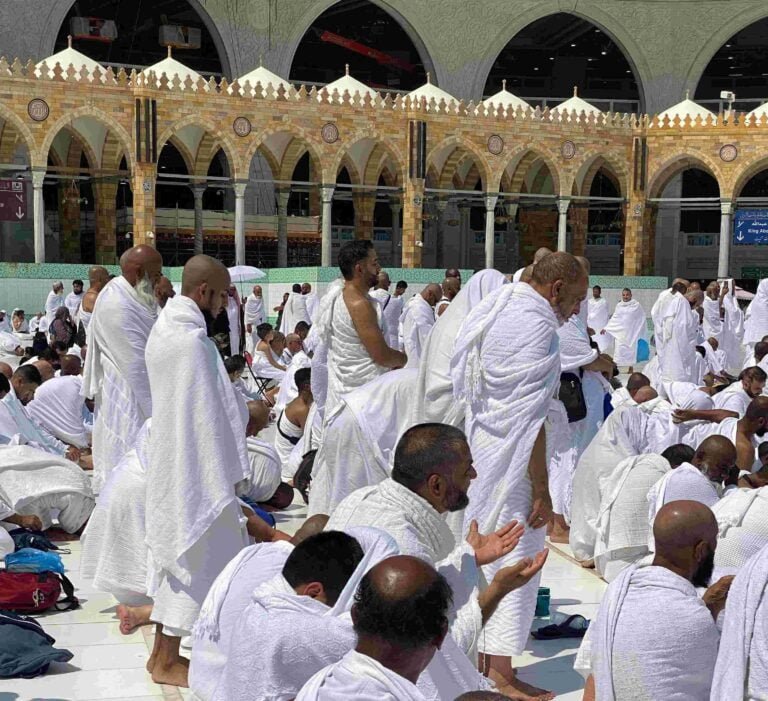Concept of Four Imams in Islam
The 4 Imams in Islam are the most prominent figures in Islamic knowledge and jurisprudence history. They are known for their vast knowledge, wisdom, and contribution to Islamic law and theology development. The four Imams in Islam is also known as Aima Arba.
Read our other best blog o the Sihah Sitta – 6 Authentic Hadith Books.
The word “fiqh” literally means “understanding” or “comprehension” in Arabic. Islamic jurisprudence cannot be discussed apart from the scope of the four great imams of fiqh and their schools of thought. It is important to know and understand that despite their differences of opinion on matters of fiqh, these blessed Imams had nothing but the utmost respect for each other. A study of their lives will show how much respect and honor they had for each other.
Each Imam developed his methodology and approach to interpreting and deriving rulings from the Quran and Sunnah (the teachings and practices of the Prophet Muhammad (SAW)). His schools of thought, known as madhabs, became influential and were followed by Muslims worldwide.
Names of Four Imams
4 Imams in Islam:
Were all great Muslims and very important figures in the history of Islam. His teachings laid the foundation for Islamic jurisprudence (fiqh).
Imam Abu Hanifa
Hazrat Imam Abu Hanifa Nu’man Ibn Thabit Ibn Zuta Ibn mah Kufi (RA) commonly known by his surname Abu Hanifa, or by Sunni Muslims as Imam Abu Hanifa. He is also known as the (Imam al-Azam) and the Imam of the Imams. According to most sources, he was born in Kufa, Iraq, in 80 AH (699 AC). His father, Thabit Ibn Zuta, was a Persian.
Teachers of Imam Abu Hanifa
According to most of his teachers, the scholars at this time were among the Tabieen and the Taba Tabieen:
- Nafi Maula ibn Umar (d. 117H)
- Amar bin Deenar (d. 126H)
- Amir bin Shraheel Shabi (d. 103H)
- Hamad bin Abi Sulaiman (d. 120H)
- Ata Ibn Rabah (d. 114H)
- Tauos bin Keesan (d. 106H)
Students of Imam Abu Hanifa
Imam Abu Hanifa had thousands of students. Twenty-eight disciples of Imam Abu Hanifa became Qazis in different towns, cities, and provinces, and eight became Imams. Some of the students of Imam Abu Hanifa are as follows:
- Imam Abu Yusuf (d. 182H)
- Imam Muhammad bin Hasan Shaibani (d. 189H)
- Imam Zufr (d. 158H)
- Imam Hassan bin Ziyad (d. 204H)
- Imam Hamad bin abi Hanifa (d.176H)
Imam Abdullah bin Mubarak (d.181H)
Books of Imam Abu Hanifa
Some of the books directly written by Imam Abu Hanifa are:
- Fiqh al-Akbar
- Kitab al-Radalat al-Qadiriya
- Knowledge and Learning
- Fiqh al-Ibast
The Book of Disagreement of the Companions:
- Kitab al-Jaami
- Al-Kitab Al-Awsat
- Kitab al-Sair
- Risalah Abu Hanifa Ali Uthman al-Bayti
The Will of Imam Abu Hanifah in Al-Tawheed.
Death of Imaam Abu Hanifa
He died around 150 AH (767 AC) in Baghdad, aged 70, from abuse in prison or perhaps poison.
Imam Abu Abdulah Malik
Imam Abu Abdullah Malik bin Anas bin Malik Asbahi al-madani. He is commonly known as Imam Malik. Imam Abu Malik was born in Medina in 93 AH. He grew up in an environment steeped in knowledge and began learning from a young age. Due to his intelligence, he was allowed to issue fatwas at the young age of 21. He considered it sufficient to learn from the scholars who came to Medina. He taught knowledge in Madinah. Thus, he was known as “Imam Dar al-Hujra” (Imam of the Land of Migration), and during his lifetime, he never left Madinah except for the major and minor Hajj. The famous book of Imam Malik is al-Muwatta.
Teachers of Imam Abu Abdullah Malik
Among his teachers were as follows:
- Nafi’ Maula ibn Umar (d. 117H)
- Muhammad bin Shihab Zuhri (d. 124H)
- Muhammad bin Minkadr (d. 130H)
- Yahya bin Saeed Ansari (d.143H)
- Hisham bin Urwa (d. 145H)
- Abdullah bin Yazeed ibn Hurmaz (d. 148H)
Students of Imam Abu Abdullah Malik
Among his students were as follows:
- Muhammad bin Hasan Shaibani (d. 189H)
- Abdur Rahman bin Qasim (d. 191H)
- Ashhab bin Abdul Aziz (d. 204H)
- Abdul Malik bin Majshoon (d. 214H)
- Abdullah bin Maslma Qanabi (d. 234H)
Books of Imam Abu Abdullah Malik
Some books are as follows:
- Muwatta Imam Malik
- Kitab al-Tafsi’r Li-Gri’b al-Quran
- Risala Fil-Aqdiyah
- Risala Ijma’ Ah-lal Madina
Death of Abu Malik
Imam Malik died at the age of 84 in 795 AD in Madinah and is buried in the famous Jannat al-Baqi cemetery in front of Masjid al-Nabawi.
Imam Shafi
The Imam’s full name is Abu Abdullah Muhammad ibn Idris al-Shafa’i ibn al-Abbas ibn Uthman ibn Saifi ibn Ubaid ibn Abd Yazid ibn Hasim ibn al-Muttalib [Abd al-Muttalib’s father, grandfather of the Prophet] ibn Abd Manaf. He is the only Imam who is related to Prophet Muhammad (peace be upon him) because he belonged to the Quraysh crew of Banu al-Muttalib, which was the brother-in-law crew of Banu Hashim.
Teachers of Imam Shafi
Imam Shafi’ learned from scholars in different places like Mecca, Medina, Kufa, Basra, Yemen, Syria, and Egypt. Some of the prominent scholars who taught Shafi are as follows:
- Malik bin Anas (d.179H)
- Muhammad bin Hasan Shaibani (d. 189H)
- Waqi’ bin Al-Jurah (d. 197H
- Sufyan bin Ainiyah (d. 198H)
- Muslim bin Khalid Az-zanji (d. 179H)
- Ismail bin Ibrahim Al-ma’roof ibn Ulya (d. 193H)
Student of Imam Shafi
Al-Shafi’i had many gifted students, some of whom became distinguished masters. Among his best students:
- Hazrat Imam Ahmad bin Hanbal (d. 241H)
- Ishaq bin Rahwiyah (d. 234H)
- Abu Saur Ibrahim bin Khalid Kalbi (d. 240H)
- Abu Ali Hussain bin Ali Krabeesi (d. 248H)
- Abu Ali Hassan bin Muhammad Za’frani (d. 260H
- Imam Ismail bin Yahya Muzni (d. 264H)
He also met Imam Ahmad bin Hambi and acquired mutual knowledge between the two.
Books of Imam Shafi
He authored more than 100 books. Some of these are as follows:
- Kitab al-Alam
- Al-Risalah
- Discord of Hadith
- Alamlat
- The Iraqi Dissent
- Jama’at-ul-Ilam
- Difference between Malik Al-Shafi
- Kitab al-Hijjah.
Death of Imam Shafi
He died in the year 204 AH (820 AC) at the age of 54 on a Friday in the month of Rajab of the Islamic calendar.
Imam Ahmad bin Hanbal
Imam Abu Abdullah Ahmad bin Muhammad bin Hanbal Shibani was the last of the four Imams in Islam of Hanbal jurisprudence. He was known as Ibn Hanbal. He was born in 780 in the city of Baghdad. Imam Ibn Hanbal (may Allah have mercy on him) studied various subjects in his city and traveled far and wide in search of knowledge. He primarily focused on acquiring knowledge of the blessed hadiths of the Messenger of Allah (PBUH).
Teachers of Imam Hanbal
Teachers of Ahmad bin Hanbal as follows:
- Imam Abu Yusuf (d. 182H)
- Waqi’ bin Al-Jurah (d. 197H)
- Sufyan bin Ainiyah (d. 198H)
- Imam Muhammad bin Idris Shafi (d. 204)
- Abdul Razzaq bin Hmam San’ani (d. 211H)
- Yahya bin Mai’n (d. 233H)
Students of Imam Ahmad bin Hanbal
Students of Imam Ahmad were:
- Abdur Rahman bin Mahdi (d.198H)
- Muhammad bin Ismail Bukhari (d. 256H)
- Muslim bin Hajjaj Qushairi (d. 261H)
- Abu Dawood Sulaiman bin Asha’s (d. 275)
- Imam abu Zara’h Razi (d. 264H)
- Abdullah bin Ahmad bin Hanbal (d. 290H)
Books of Imam Ahmad bin Hanbal
Some of the book’s names are as follows:
- Musnad
- Resala Shalat
- Al Masail
- Al Ashriba
- Fadhail
- Ash Shahabah
Death of Imam Ahmad bin Hanbal
He passed away on 12 Rabi Al-Awwal 241 Hijri at the age of 77.
Conclusion
In conclusion, the enduring impact of the four Imams in Islam—Abu Hanifa, Malik, Shafi’i, and Ahmad bin Hanbal—resonates through their contributions, shaping the rich tapestry of Islamic jurisprudence. Their teachings and methodologies, encapsulated in the Hanafi, Maliki, Shafi, and Hanbali madhabs, continue to guide and inspire Muslims. Worldwide fostering a deep respect for diverse perspectives within the Islamic legal tradition. The teachings of the Four Imams in Islam despite variations in their approaches. The unity of purpose among these esteemed scholars underscores the profound respect and honor. They held for one another, leaving an indelible mark on the history and understanding of Islamic law.
Frequently Asked Questions (FAQs)
The number of nineteen fiqhs of jurisprudence that developed during the first four centuries of Islam has reduced to five, of which four are Sunni and one is Shia. The Sunni fiqhs are Hanafi, Maliki, Shafi and Hanbali, and the Shia fiqh is Jafari.
The first imam of the four imams of Islamic jurisprudence (fiqh) was Abu Hanifa al-Nu`man (RA). He met Imam Ali ibn Abi Talib and became his follower. He is known as the greatest imam (imam al-Azam) and the imam of the imams.
There are four madhabs are as follows Hanafi, Maliki, Shafi and Hanbali.
The 4 great Sunni Imams Imam Nu’man Ibn Thabit (Abu Hanifa), Imam Abu Abdullah Malik Ibn Anas bin Malik, Imam Abu Abdullah Muhammad ibn Idris, and Imam Abu Abdullah Ahmad bin Muhammad bin Hanbal Shibani.
Imams are leaders who help Muslims follow Islam. There are four famous Imams in Islam: Abu Hanifa, Malik, Shafi’i, and Ahmad ibn Hanbal. They wrote down Islamic rules based on the Quran and what Prophet Muhammad (SAW) said and did. Each Imam had a different way of writing the rules to fit different places and times. Muslims can use these rules to know how to pray and how to live, making Islam a rich and diverse religion.










Allah bless you and improve your research that will guide all Muslim. Ameen